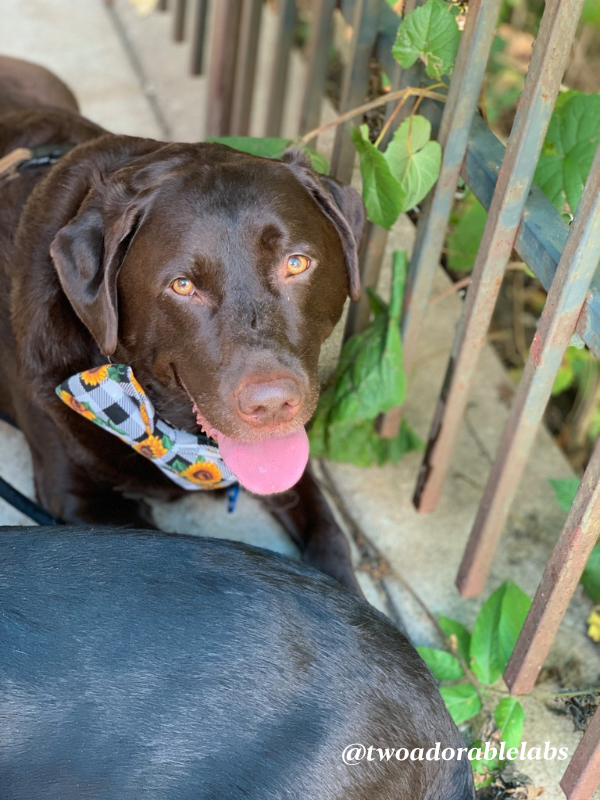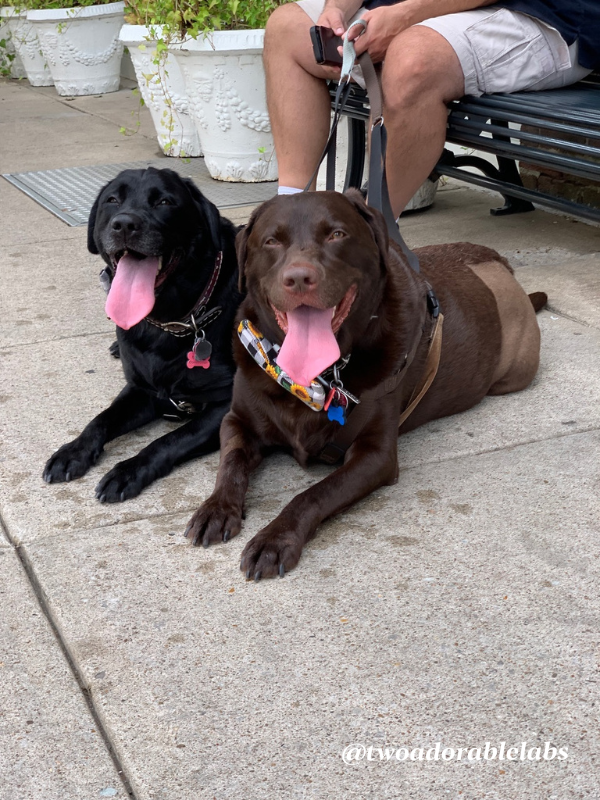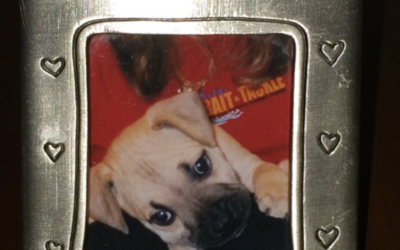11 First Aid Procedures For Your Dog In Case Of Emergency
Jake scoping out another diner's dog at Meridees Breadbasket in Franklin, TN

While most wounds are not life-threatening, it’s important to know how to stop bleeding and apply a pressure wrap. A well-stocked dog first aid kit should contain gauze and non-adhesive wraps to apply pressure and protect the wound. I bought mine from Chewy.com and always take it on vacation with us when the dogs are going with us!
- Press a clean, thick gauze pad over the wound and apply pressure with your hand until the blood starts clotting (this will take a minimum of 3 minutes for larger wounds).
- For severe bleeding on the extremities, apply a tourniquet using the gauze and adhesive wrap from your first aid kit.
- Since pressure wraps minimize circulation, loosen the tourniquet for 20 seconds every 15-20 minutes.
- Seek veterinary attention immediately.
If a wound is severe enough or caused by a stressful event such as an animal attack or car accident, shock is a real and very serious possibility.
Shock is a lack of oxygen to the tissues of the body, usually caused by a fall in blood volume or blood pressure. Shock occurs as a result of the body’s circulatory system failing to work properly, which means that the tissues and organs of the body, including the heart and the brain, struggle to get sufficient oxygen. The body’s response to this is to shut down the circulation to the skin, the heart speeds up as it tries to get sufficient blood supply and oxygen around the body and blood supply is drawn away from the gut to prioritise vital organs; which causes the animal to feel sick and thirsty and can lead to collapse. Shock results from major drop in blood pressure and is serious.
- Rapid pulse
- Low body temperature
- Grey-blue mucous membranes (gums, tongue, etc.)
- Weakness and dizziness
- Nausea and vomiting
- Shallow, rapid breathing
- Gasping for air
- Eventually, they will lose consciousness and stop breathing without life-saving efforts
Dog first aid steps for shock:
- Lie the dog on their right side
- Put a folded blanket under their hind end to elevate it. This encourages blood to flow to their heart and brain.
- Cover them with a warm blanket (shock causes body temp to plummet)
- Seek emergency veterinary care
- Hypovolaemic– the body loses fluid, such as with major bleeds (internal and external), burns, diarrhoea and vomiting.
- Cardiogenic– heart attack i.e. the heart is not pumping effectively.
- Anaphylactic– the body reacts to something, releasing large amounts of Histamine and other hormones. These dilate the blood vessels and cause them to leak fluid, causing swelling of the airways and leading to a triple whammy of shock.
- Extremes of temperature.
- Major assault on the nervous system such as a spinal or brain injury.
Maggie watching me from across the street in downtown Franklin, TN

In the case of toxic ingestion, call your veterinarian or the Animal Poison Control Center hotline at 888-4ANI-HELP (888-426-4435). Animal Poison Control is available 24 hours a day, 365 days a year. Have the packaging of the substance your dog was exposed to on-hand.
First aid techniques may involve inducing vomiting or seeking emergency supportive care from your vet. While some substances are best removed from the body as soon as possible, others can cause even more damage on the way out. Never induce vomiting without first seeking professional advice.
Depending on the type of exposure, you may also have to flush the eyes or thoroughly wash the skin and coat.
4. Seizures – see my last post What Is A Tonic-Clonic Seizure In Dogs?
Seizures can take on a variety of forms. Some dogs convulse violently while others experience rapid eye movement or twitching in one limb. It’s extremely frightening to witness, but canine seizures are typically not life-threatening unless they cannot be brought under control.
If your dog has a seizure, do not attempt to move or restrain them. Clear the area of potential hazards and time the length of the seizure to report to your vet.
Once the seizure has passed, your dog will most likely be listless and groggy for several hours. Keep them comfortable. If this is your dog’s first seizure, seek immediate veterinary attention. If your dog has a history of seizure disorder, follow your veterinary care plan.
5. Choking
Note: A choking, frightened dog is more likely to bite. Proceed with caution.
Many dogs cough and hack, but are not necessarily choking. To determine if your dog is in need of emergency first aid:
- Check for labored breathing.
- Gently open your dog’s mouth and see whether an object is blocking the airway.
- If visible, try to dislodge it with a hooked index finger, being careful not to push it further into the airway.
- If you can’t remove the object or your dog collapses, place both hands on the side of the rib cage and apply firm quick pressure, release and repeat.
- You can also try laying your dog on its side and striking the rib cage firmly with the palm of your hand 3-4 times. (The idea behind this is to sharply push air out of their lungs and push the object out from behind.)
- Keep repeating these techniques until the object is dislodged or until you arrive at the vet’s office.
- Seek emergency veterinary care.
Even if you are able to dislodge the object from your dog’s throat, you should still seek veterinary attention as soon as possible to ensure there are no further complications. Choking dogs may swallow potentially harmful substances or aspirate fluid into the lungs.
Jake at Americana Taphouse in downtown Franklin, TN

You can determine if your dog has stopped breathing by watching for the rise and fall of the chest or placing your hand in front of your dog’s muzzle to feel for warm, exhaled air. Keep in mind that your dog’s respiration is slower and deeper during sleep.
Sleep apnea can be pretty serious for your pooch. The most severe cases can result in death, but even a mild instance can disrupt your dog’s sleep. Symptoms include: Loud and frequent snoring.
If you determine that your dog is in respiratory distress, the AVMA recommends you:
- Open the airway by gently grasping the tongue and pulling it forward (out of the mouth) until it is flat.
- Check the dog’s throat to see if there are any foreign objects obstructing the airway.
- Perform rescue breathing by holding your dog’s muzzle closed and breathing directly into the nose until the chest expands.
- Once the chest expands, continue the rescue breathing once every 4 or 5 seconds.
- Be sure to check for a pulse (see video below). If absent, proceed to cardiac arrest procedures.
Ideally, these dog first aid techniques should be preformed on the way to your veterinarian’s office to seek professional treatment.
The signs of cardiac arrest are similar to those seen in the advanced stages of shock. Your dog will lose consciousness and stop breathing. Since the heart is no longer pumping oxygenated blood through the body, the mucous membranes will appear pale or blue-gray.
This is one of the most terrifying emergencies your dog can face, but with your help, they may just survive it. Prompt veterinary care is the key to a happy outcome, so be sure to perform the following rescue efforts on the way to the animal hospital.
Dog First Aid For Cardiac Arrest:
- First, check to make sure your dog doesn’t have anything blocking their airway and begin performing the rescue breathing technique from above.
- Check for a pulse (see video below).
- If no pulse, lay them on their RIGHT side so the heart is facing up. (It is located in the lower half of the chest on the left side, just behind the front left leg.)
- Place one hand underneath your dog and the other hand over their heart.
- Press down gently on the heart – about one inch down for medium-sized dogs – 100-120 times per minute.
- Alternate 30 chest compressions with two rescue breaths and check for signs of life every two minutes.
- Continue until your dog’s heart restarts or a veterinary professional is available to take over.
Maggie relaxing at the cottage in Franklin, TN

8. Heat Stroke
Heat stroke is a term commonly used for hyperthermia or elevated body temperature. Generally speaking, if a pet’s body temperature exceeds 103°F (39.4°C), it is considered abnormal or hyperthermic. Body temperatures above 106°F (41°F) without previous signs of illness are most commonly associated with exposure to excessive external or environmental heat and are often referred to as heat stroke. The critical temperature where multiple organ failure and impending death occurs is around 107°F to 109°F (41.2°C to 42.7°C). Overweight pups and dogs with short muzzles are even more prone to heat stroke.
Symptoms of heat stroke include:
- Excessive panting
- Drooling
- Fast or irregular heartbeat
- Vomiting blood
- Muscle tremors
- Seizures
If you believe your dog is suffering from heat stroke, get them out of the heat immediately. Prompt veterinary care is essential to prevent brain and organ damage, but you can help begin the process of lowering your dog’s body temperature (slowly!) on the way to the clinic. Lowering the temp at a steady pace also helps reduce the risk of shock.
- Apply rubbing alcohol to your dog’s paw pads to help draw heat out of the body.
- Place cool, wet towels around the body, head, and neck (avoiding the eyes, nose, and mouth).
- If possible, replace with fresh, cool towels every few minutes until your vet can take over care.
9. Broken Bones
Dogs don’t have an understanding of what it means to have broken bones. When a dog breaks a bone, they tend to do things that make the situation worse. Remember: even the sweetest dogs will bite or growl at their rescuers out of fear and confusion. It helps to muzzle your dog or the dog you’re attempting to help so they don’t nip at you while you transport them.
Dogs will also try to move the broken bones instinctively and you need to make sure they don’t do this. The first step will be to secure the dog so they don’t injure themselves accidentally. Transporting a dog with broken bones requires additional care, and to do this safely you’ll need to:
- Lay the dog on a flat surface to use as a stretcher, like a board or floor mat.
- Secure the dog to that flat surface using a blanket, towel, or other soft material. Don’t make the restraint tight enough to restrict blood flow.
- Make sure you’re not putting any pressure on the injury as you’re securing your dog.
Remember, you’re doing all this so you can safely bring the dog to a veterinarian. A badly placed splint or improper set can do more harm than good. It’s best to leave medical care to the professionals.
Jake And Maggie relaxing with their dad after a walk around downtown Franklin, TN

When treating burns, there are different methods based on the type of severity of the burn. In every case, you should muzzle your dog if possible to avoid fear bites.
For chemical burns, brush off any dry chemicals. Then, immediately flush the area with large quantities of water. Note that some dry chemicals may react to water. Check the product label and see what the emergency instructions for people are. Odds are if soap and water is required on human’s skin, your dog’s skin will need to be treated with soap as well.
If the burn is severe, apply an ice water compress for at least 5 minutes. Ice should not be applied directly to your dog’s skin, so wrap an ice pack in a light towel.
You can also apply soothing aloe lotion to your dog’s skin before taking them in for professional treatment.
11. Stings And Insect Bites – see my last post “What To Do If Your Dog Has Been Stung By A Bee“
If your dog gets stung or bitten by an insect, observe them for signs of allergic reactions. Those signs include:
- General weakness
- Difficulty breathing
- Swelling that extends past the bite/sting area
Though dogs can take Benadryl, the safe amount depends on your dog’s weight. Allergic reactions constitute an emergency and your dog will need to be treated by a veterinarian right away.
Otherwise, stings tend to go away on their own. Attempting to remove the stinger with tweezers could actually release more venom, so try knocking it off with something else. If the bite or sting is external, apply an ice pack or compress to help with any lingering pain.
For naughty pups who got stung trying to eat an insect, consult your vet on pain medications for dogs. Bites and stings occurring in the mouth and throat are most likely to be dangerous, and you may want to have a vet investigate these.
Want more pet health related posts:


I’m Bobbi Jo, a lab-lover who took my passion for animals and dogs and turned it into something bigger. When I adopted Jake and Maggie, my love for them became the driving force behind Two Adorable Labs, and my blog was born. My hope is to not only share them with the world, but to help educate others on the importance of animal health and well-being.
I love hearing from all of you and do my best to respond to each and every one of you. I always enjoy your comments, feedback, and suggestions so keep them coming! If I’ve posted a recipe (for our human and our furry friends) and you try it, don’t forget to tag me on Instagram @twoadorablelabs and use #twoadorablelabs.
If you do try and love my recipes, I would greatly appreciate a comment and rating. I read every single one and respond to them. It also lets Google know that the website contains quality content. The more comments and 5-star ratings, the more Google will show my blog in search results! Thank you so much!
As an Amazon Associate, I earn from qualifying purchases.

You Might Also Like
What Are The Nutritional Stages Over A Dog’s Lifespan?
Happy Wednesday everyone! It’s been a minute since I last posted. It’s been a crazy busy time for us and it doesn’t look like it’s going to stop any time soon but I didn’t forget about you. I’m back and ready to blog! One of my loyal readers has suggested I create...
Your Dog’s Zodiac Sign
Happy Wednesday everyone! Ever wonder what your pet's reaction means to something? Your Dog's Zodiac Sign is a fun post that sheds light on their behavior based on the month they were born. Jake and Maggie are Gemini's born June 8, 2017! The horoscope (see chart)...
The Stigma Surrounding The Pitbull Breed
Happy Wednesday everyone! Today on the blog we are talking about The Stigma Surrounding The Pitbull Breed. For those of you who have never owned a Pitbull, I want to tell you that they are a wonderful breed. So when I heard about the UK banning all XL bully dog...
New Years Table With Pink And Red Showcasing Ava’s Candles
Happy New Years!!!! I’m so excited to talk about my New Years Table With Pink And Red Showcasing Ava’s Candles!!!!! The colors on this table were inspired by the colors of my bedroom when I was a child. Yes, I had a pink and red bedroom and it was beautiful. I...
Merry Christmas
I wanted to take this time to wish all of you a Merry Christmas and thank you for all of your support, ideas, thoughts, and suggestions along the way. I have many things to be thankful for and am grateful that I have this blog which gives me the opportunity to let my...
What Is A Cat’s Primordial Pouch?
Happy Wednesday everyone! Today on the blog we are answering What Is a Cat's Primordial Pouch? My sister adopted a kitten and as he grows, he is developing a very large stomach. I commented on how big he is getting and she said it’s a Primordial Pouch. As soon as...







0 Comments